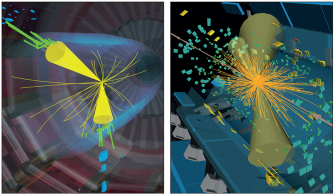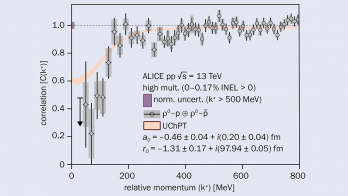With the story of quarkonia entering its final chapter, John Ellis shares personal recollections of five decades of discoveries and debates about the simplest composite object in QCD, whose history is inextricable from the development of particle physics.

The world of particle physics was revolutionised in November 1974 by the discovery of the J/ψ particle. At the time, most of the elements of the Standard Model of particle physics had already been formulated, but only a limited set of fundamental fermions were confidently believed to exist: the electron and muon, their associated neutrinos, and the up, down and strange quarks that were thought to make up the strongly interacting particles known at that time. The J/ψ proved to be a charm–anticharm bound state, vindicating the existence of a quark flavour first hypothesised by Sheldon Glashow and James Bjorken in 1964 (CERN Courier January/February 2025 p35). Its discovery eliminated any lingering doubts regarding the quark model of 1964 (see “Nineteen sixty-four“) and sparked the development of the Standard Model into its modern form.
This new “charmonium” state was the first example of quarkonium: a heavy quark bound to an antiquark of the same flavour. It was named by analogy to positronium, a bound state of an electron and a positron, which decays by mutual annihilation into two or three photons. Composed of unstable quarks, bound by gluons rather than photons, and decaying mainly via the annihilation of their constituent quarks, quarkonia have fascinated particle physicists ever since.
The charmonium interpretation of the J/ψ was cemented by the subsequent discovery of a spectrum of related cc–states, and ultimately by the observation of charmed particles in 1976. The discovery of charmonium was followed in 1977 by the identification of bottomonium mesons and particles containing bottom quarks. While toponium – a bound state of a top quark and antiquark – was predicted in principle, most physicists thought that its observation would have to wait for the innate precision of a next-generation e+e– collider following the LHC, in view of the top quark’s large mass and exceptionally rapid decay, more than 1012 times quicker than the bottom quark. The complex environment at a hadron collider, where the composite nature of protons precludes knowledge of the initial collision energy of pairs of colliding partons within them, would make toponium particularly difficult to identify at the LHC.
However, in the second half of 2024, the CMS collaboration reported an enhancement near the threshold for tt production at the LHC, which is now most plausibly interpreted as the lowest-lying toponium state. The existence of this enhancement has recently been corroborated by the ATLAS collaboration (see”ATLAS confirms top–antitop excess“).
Here are the personal memories of an eyewitness who followed these 50 years of quarkonium discoveries firsthand.
Strangeonium?
In hindsight, the quarkonium story can be thought to have begun in 1963 with the discovery of the φ meson. The φ was an unexpectedly stable and narrow resonance, decaying mainly into kaons rather than the relatively light pions, despite lying only just above the KK threshold. Heavier quarkonia cannot decay into a pair of mesons containing single heavy quarks, as their masses lie below the energy threshold for such “open flavour” decays.
The preference of the φ to decay into kaons was soon interpreted by Susumu Okubo as a consequence of approximate SU(3) flavour symmetry, developing mathematical ideas based on unitary 3 × 3 matrices with a determinant one. At the beginning of 1964, quarks were proposed and George Zweig suggested that the φ was a bound state of a strange quark and a strange anti-quark (or aces as he termed them). After 1974, the portmanteau word “strangeonium” was retrospectively applied to the φ and similar heavier ss bound states, but the name has never really caught on.
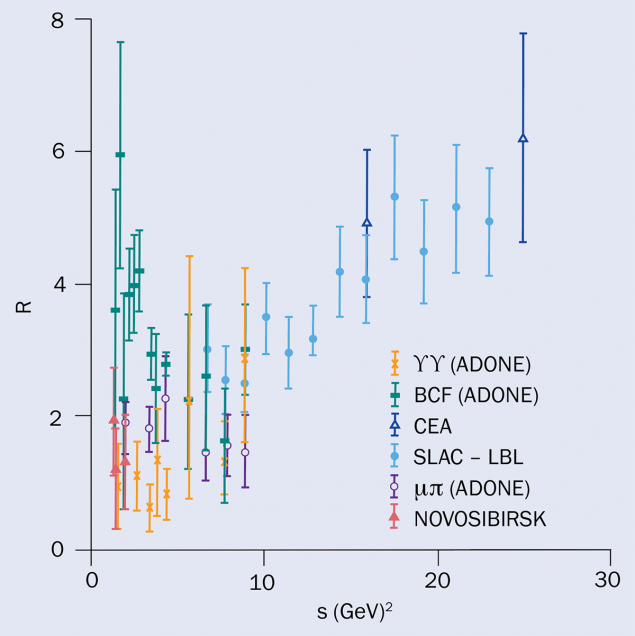
In the year or so prior to the discovery of the J/ψ in November 1974, there was much speculation about data from the Cambridge Electron Accelerator (CEA) at Harvard and the Stanford Positron–Electron Asymmetric Ring (SPEAR) at SLAC. Data from these e+e– colliders indicated a rise in the ratio, R, of cross-sections for hadron and μ+μ– production (see “Why is R rising?” figure). Was this a failure of the parton model that had only recently found acceptance as a model for the apparently scale-invariant internal structure of hadrons observed in deep-inelastic scattering experiments? Did partons indeed have internal structure? Or were there “new” partons that had not been seen previously, such as charm or coloured quarks? I was asked on several occasions to review the dozens of theoretical suggestions on the market, including at the ICHEP conference in the summer of 1974. In preparation, I toted a large Migros shopping bag filled with dozens of theoretical papers around Europe. Playing the part of an objective reviewer, I did not come out strongly in favour of any specific interpretation, however, during talks that autumn in Copenhagen and Dublin, I finally spoke out in favour of charm as the best-motivated explanation of the increase in R.
November revolution
Then, on 11 November 1974, the news broke that two experimental groups, one working at BNL under the leadership of Sam Ting and the other at SLAC led by Burt Richter, had discovered, in parallel, the narrow vector boson that bears the composite name J/ψ (see “Charmonium” figure). The worldwide particle-physics community went into convulsions (CERN Courier November/December 2024 p41) – and the CERN Theory Division was no exception. We held informal midnight discussion sessions around an open-mic phone with Fred Gilman in the SLAC theory group, who generously shared with us the latest J/ψ news. Away from the phone, like many groups around the world, we debated the merits and demerits of many different theoretical ideas. Rather than write a plethora of rival papers about these ideas, we decided to bundle our thoughts into a collective preprint. Instead of taking individual responsibility for our trivial thoughts, the preprint was anonymous, the place of the authors’ names being taken by a mysterious “CERN Theory Boson Workshop”. Eagle eyes will spot that the equations were handwritten by Mary K Gaillard (CERN Courier July/August 2025 p47). Informally, we called ourselves Co-Co, for communication collective. With “no pretentions to originality or priority,” we explored five hypotheses: a hidden charm vector meson, a coloured vector meson, an intermediate vector boson, a Higgs meson and narrow resonances in strong interactions.
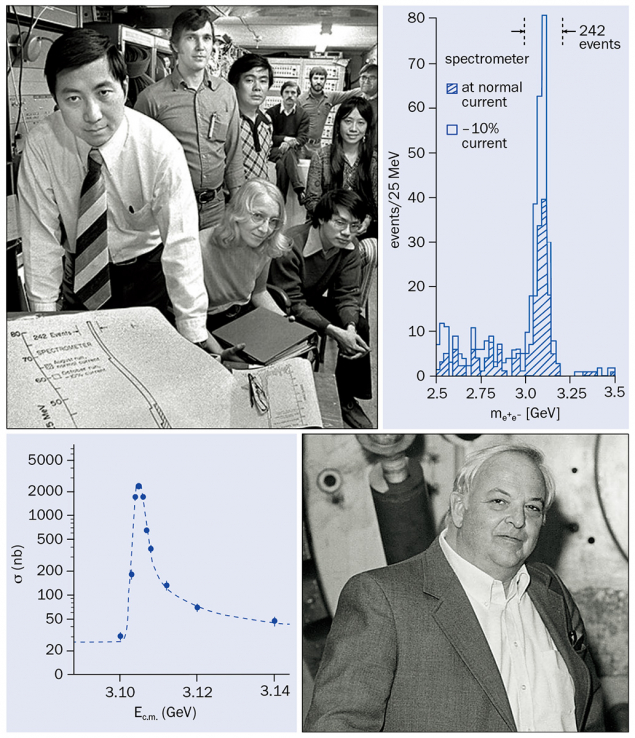
My immediate instinct was to advocate the charmonium interpretation of the J/ψ, and this was the first interpretation to be described in our paper. This was on the basis of the Glashow–Iliopoulos–Maiani (GIM) mechanism, which accounted for the observed suppression of flavour-changing neutral currents by postulating the existence a charm quark with a mass around 2 GeV (see CERN Courier July/August 2024 p30), and the Zweig rule, which suggested phenomenologically that quarkonia do not easily decay by quark–antiquark annihilation via gluons into other flavours of quarks. So I was somewhat surprised when one of the authors of the GIM paper wrote a paper proposing that it might be an intermediate electroweak vector boson. A few days after the J/ψ discovery came the news of the (almost equally narrow) ψ′ discovery, which I was told as I was walking along the theory corridor to my office one morning. My informant was a senior theorist who was convinced that this discovery would kill the charmonium interpretation of the J/ψ. However, before I reached my office I realised that an extension of the Zweig rule would also suppress ψ′ → J/ψ + light meson decays, so the ψ′ could also be narrow.
Keen competition
The charmonium interpretation of the J/ψ and ψ′ states predicted that there should be intermediate P-wave states (with one unit of orbital angular momentum) that could be detected in radiative decays of the ψ′. In the first half of 1975 there was keen competition between teams at SLAC and DESY to discover these states. That summer I was visiting SLAC, where I discovered one day under the cover of a copying machine, before their discovery was announced, a sheet of paper with plots showing clear evidence for the P-wave states. I made a copy, went to Burt Richter’s office and handed him the sheet of paper. I also asked whether he wanted my copy. He graciously allowed me to keep it, as long as I kept quiet about it, which I did until the discovery was officially announced a few weeks later.
The story of quarkonium can be thought to have begun in 1963 with the discovery of the φ meson
Discussion about the interpretation of the new particles, in particular between advocates of charm and Han–Nambu coloured quarks – a different way to explain the new particles’ astounding stability by giving them a new quantum number – rumbled on for a couple of years until the discovery of charmed particles in 1976. During this period we conducted some debates in the main CERN auditorium moderated by John Bell. I remember one such debate in particular, during which a distinguished senior British theorist spoke for coloured quarks and I spoke for charm. I was somewhat taken aback when he described me as representing the “establishment”, as I was under 30 at the time.
Over the following year, my attention wandered to grand unified theories, and my first paper on the subject was with Michael Chanowitz and Mary K Gaillard, which we completed in May 1977. We realised while writing this paper that simple grand unified theories – which unify the electroweak and strong interactions – would relate the mass of the τ heavy lepton that had been discovered in 1975 to the mass of the bottom quark, which was confidently expected but whose mass was unknown. Our prediction was mb/mτ = 2 to 5, but we did not include it in the abstract. Shortly afterwards, while our paper was in proof, the discovery of the ϒ state (or states) by a group at Fermilab led by Leon Lederman (see “Bottomonium” figure) became known, implying that mb ~ 4.5 GeV. I added our successful mass prediction by hand in the margin of the corrected proof. Unfortunately, the journal misunderstood my handwriting and printed our prediction as mb/mτ = 2605, a spectacularly inaccurate postdiction! It remains to be seen whether the idea of a grand unified theory is correct: it also predicted successfully the electroweak mixing angle θW and suggested that neutrinos might have mass, but direct evidence, such as the decay of the proton, has yet to be found.
Peak performance
Meanwhile, buoyed by the success of our prediction for mb, Mary K Gaillard, Dimitri Nanopoulos, Serge Rudaz and I set to work on a paper about the phenomenology of the top and bottom quarks. One of our predictions was that the first two excited states of the ϒ, the ϒ′ and ϒ′′, should be detectable by the Lederman experiment because the Zweig rule would suppress their cascade decays to lighter bottomonia via light-meson emission. Indeed, the Lederman experiment found that the ϒ bump was broader than the experimental resolution, and the bump was eventually resolved into three bottomonium peaks.

It was in the same paper that we introduced the terminology of “penguin diagrams”, wherein a quark bound in a hadron changes flavour not at tree level via W-boson exchange but via a loop containing heavy particles (like W bosons or top quarks), emitting a gluon, photon or Z boson. Similar diagrams had been discussed by the ITEP theoretical school in Moscow, in connection with K decays, and we realised that they would be important in B-hadron decays. I took an evening off to go to a bar in the Old Town of Geneva, where I got involved in a game of darts with the experimental physicist Melissa Franklin. She bet me that if I lost the game I had to include the word “penguin” in my next paper. Melissa abandoned the darts game before the end, and was replaced by Serge Rudaz, who beat me. I still felt obligated to carry out the conditions of the bet, but for some time it was not clear to me how to get the word into the b-quark paper that we were writing at the time. Then, another evening, after working at CERN, I stopped to visit some friends on my way back to my apartment, where I inhaled some (at that time) illegal substance. Later, when I got home and continued working on our paper, I had a sudden inspiration that the famous Russian diagrams look like penguins. So we put the word into our paper, and it has now appeared in almost 10,000 papers.
What of toponium, the last remaining frontier in the world of quarkonia? In the early 1980s there were no experimental indications as to how heavy the top quark might be, and there were hopes that it might be within the range of existing or planned e+e– colliders such as PETRA, TRISTAN and LEP. When the LEP experimental programme was being devised, I was involved in setting “examination questions” for candidate experimental designs that included asking how well they could measure the properties of toponium. In parallel, the first theoretical papers on the formalism for toponium production in e+e– and hadron–hadron collisions appeared.
Toponium will be a very interesting target for future e+e– colliders
But the top quark did not appear until the mid-1990s at the Tevatron proton–antiproton collider at Fermilab, with a mass around 175 GeV, implying that toponium measurements would require an e+e– collider with an energy much greater than LEP, around 350 GeV. Many theoretical studies were made of the cross section in the neighbourhood of the e+e– → tt threshold, and how precisely the top quark mass, electroweak and Higgs couplings could be measured.
Meanwhile, a smaller number of theorists were calculating the possible toponium signal at the LHC, and the LHC experiments ATLAS and CMS started measuring tt production with high statistics. CMS and ATLAS embarked on programmes to search for quantum-mechanical correlations in the final-state decay products of the top quarks and antiquarks, as should occur if the tt state were to be produced in a specific spin-parity state. They both found decay correlations characteristic of tt production in a pseudoscalar state: it was the first time such a quantum correlation had been observed at such high energies.
The CMS collaboration used these studies to improve the sensitivities of dedicated searches they were making for possible heavy Higgs bosons decaying into tt final states, as would be expected in many extensions of the Standard Model. Intriguingly, hints of a possible excess of events around the tt threshold with the type of correlation expected from a pseudoscalar tt state began to emerge in the CMS data, but initially not with high significance.
Pseudoscalar states
I first heard about this excess at an Asia–CERN physics school in Thailand, and started wondering whether it could be due to the lowest-lying toponium state, which would decay predominantly into unstable top quarks and antiquarks rather than via their annihilation, or to a heavy pseudoscalar Higgs boson, and how one might distinguish between these hypotheses. A few years previously, Abdelhak Djouadi, Andrei Popov, Jérémie Quevillon and I had studied in detail the possible signatures of heavy Higgs bosons in tt final states at the LHC, and shown that they would have significant interference effects that would generate dips in the cross-section as well as bumps.
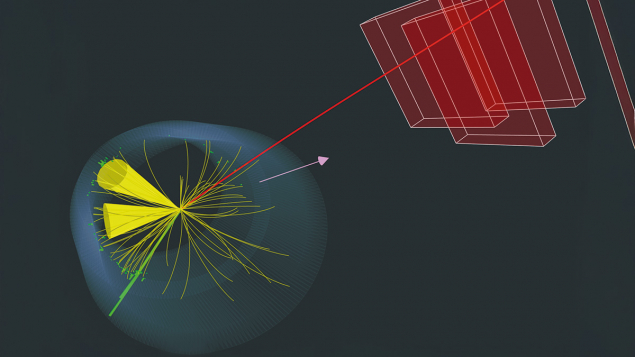
The significance of the CMS signal subsequently increased to over 5σ, showing up in a tailored search for new pseudoscalar states decaying into tt pairs with specific spin correlations, and recently this CMS discovery has been confirmed by the ATLAS Collaboration, with a significance over 7σ. Unfortunately, the experimental resolution in the tt invariant mass is not precise enough to see any dip due to pseudoscalar Higgs production, and Djouadi, Quevillon and I have concluded that it is not yet possible to discriminate between the toponium and Higgs hypotheses on purely experimental grounds.
However, despite being a fan of extra Higgs bosons, I have to concede that toponium is the more plausible interpretation of the CMS threshold excess. The mass is consistent with that expected for toponium, the signal strength is consistent with theoretical calculations in QCD, and the tt spin correlations are just what one expects for the lowest-lying pseudoscalar toponium state that would be produced in gluon–gluon collisions.
Caution is still in order. The pseudoscalar Higgs hypothesis cannot (yet) be excluded. Nevertheless, it would be a wonderful golden anniversary present for quarkonium if, some 50 years after the discovery of the J/ψ, the appearance of its last, most massive sibling were to be confirmed.
Toponium will be a very interesting target for future e+e– colliders, which will be able to determine its properties with much greater accuracy than a hadron collider could achieve, making precise measurements of the mass of the top quark and its electroweak couplings possible. The quarkonium saga is far from over.






